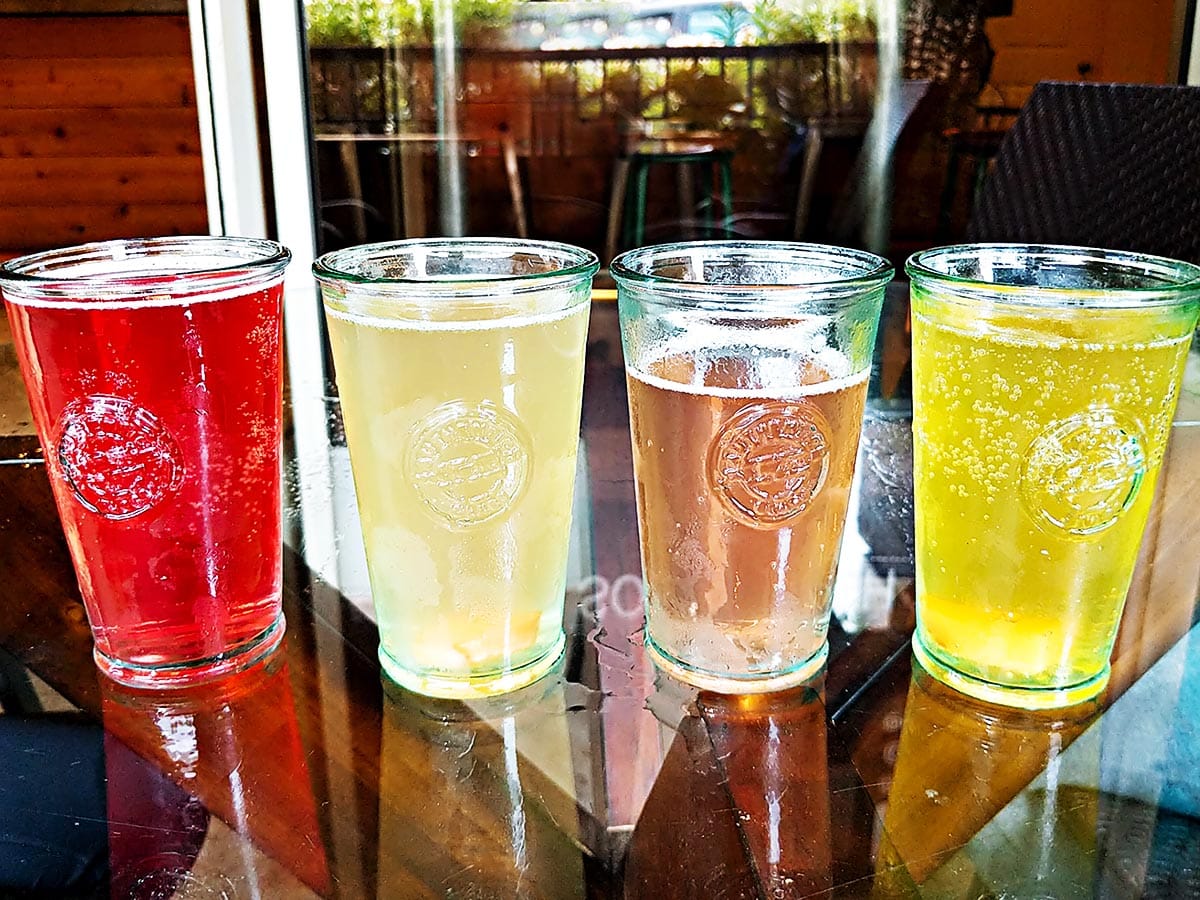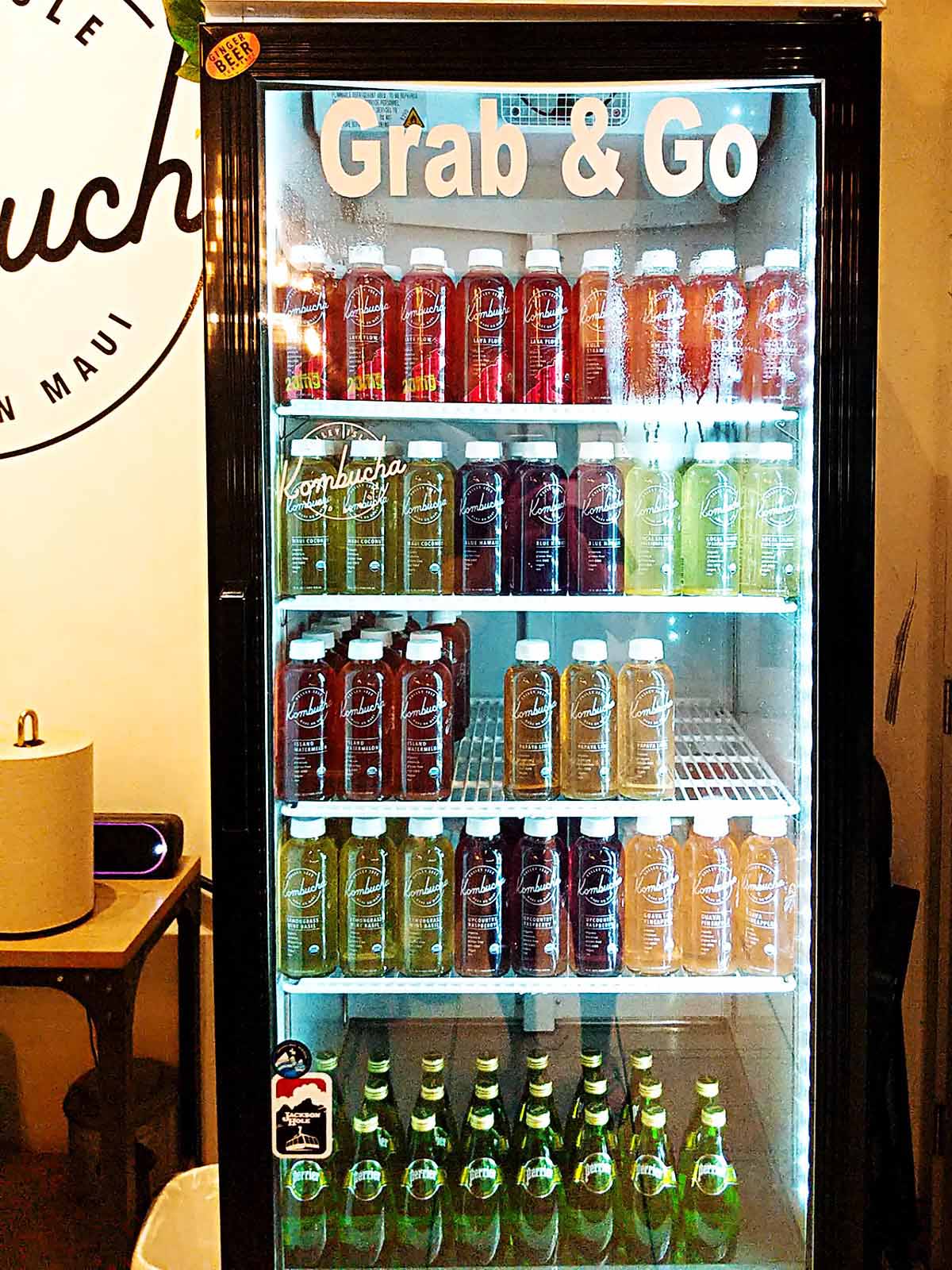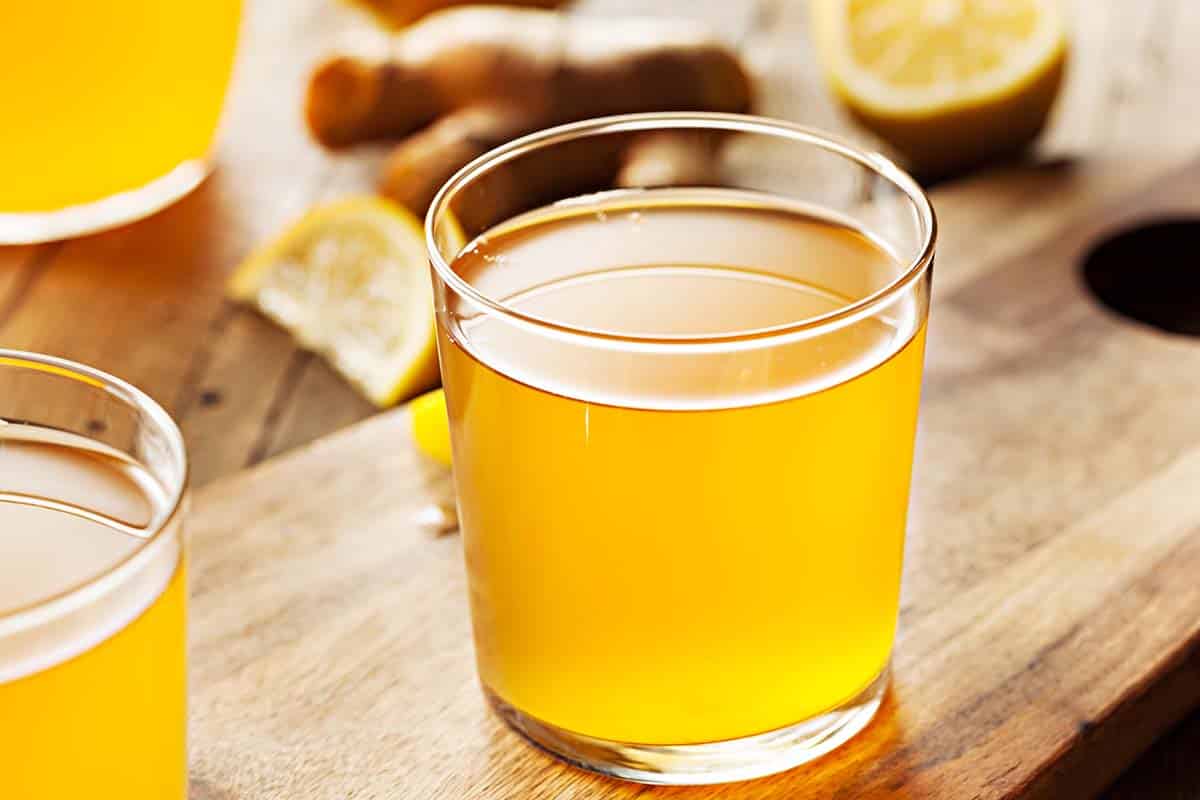Have you ever asked yourself, what does kombucha taste like? Let’s go over the details and discover what makes this unique brew taste so good.
Kombucha is an excellent drink for anyone looking to try something new and exciting. It has a variety of flavors that makes it unique from any other beverage out there. In this article, we’ll talk about the different kombucha varieties, it’s origin and many other exciting facts about this drink.

Kombucha is a fizzy fermented drink. The drink has tea, sugar, and a symbiotic culture of bacteria and yeast or “SCOBY” (Symbiotic Colony Of Bacteria and Yeast).
Although closely associated with mushrooms or fungi, SCOBY is essentially a living bacteria. It’s also called “mother,” like “mother of vinegar,” another similar bacteria.
At first glance, SCOBY looks like a rubbery disc with its texture close to silken tofu. Despite its unsavory look, SCOBY plays an essential role during fermentation. It breaks down the sugars and gives the brew its unique taste.
The fermentation process produces carbon dioxide, resulting in a sparkling fermented beverage. It has a slightly sour and sweet flavor that varies depending on the ingredients used.
People drink bottled form and brewed at-home kombucha. It has become increasingly popular due to its versatile and delicious flavors and potential health benefits.
This traditional tea originated in East Asia over 2,000 years ago. Its exact origin is still unknown.
It was most likely invented by accident in ancient China after a natural tea ferment occurred due to the environment.
Now kombucha is finding its way to Europe. In the United States, kombucha has recently become more popular and is often called “kombucha tea.”
Kombucha tea is an amber-colored liquid, similar to lemon iced tea. As it ferments, the SCOBY looks like jelly and stays afloat.
After the process, you’ll see leftover strands of SCOBY floating in the liquid.
Often, to add flavor, people also infuse the kombucha with fruits and herbs. This addition might change its color based on the exact ingredients added.
Kombucha taste is something between a sour beer and sweet tea, depending on what type of kombucha you get.
It’s naturally carbonated, and it can feel slightly fizzy in your mouth!
Unlike other beverages, the flavor of kombucha varies since it is fermented and brewed with different ingredients.
The duration of the fermentation process significantly affects the kombucha’s taste. Longer fermentation time means a more vinegary kombucha.
Generally speaking, kombucha is fizzy, acidic, and has a bittersweet flavor.
If you’re drinking kombucha for the first time, it tastes a lot like sparkling apple cider.
Kombucha has a unique and complex flavor profile with notes of tartness and sweetness.
The fermentation process drives the taste, which occurs when bacteria and yeast break down the sugar in the tea, creating an acidic by-product.
The acidic flavor is balanced during fermentation with some sweetness derived from the added sugar. The result is a refreshing, carbonated drink that can provide numerous health benefits.
Today, homebrewers are creating unique homemade kombucha teas with different ingredients and fermenting times, resulting in various flavor profiles.

Kombucha is a fermented tea drink that can have different names. It’s sometimes referred to as fermented tea, sparkling apple cider, fizzy fermented tea, and even the “elixir of life.”
Kombucha is typically served cold and has become popular with people looking for an alternative to soda or other sugary drinks.
Making kombucha tea is a long and delicate process. Much precaution is needed during fermentation to ensure it’s safe for drinking. That said, it’s possible to make your own delicious and refreshing homemade kombucha tea.
Kombucha tea consists of tea, SOBY, and sugar. Although honey is a typical pair for tea, it won’t work in this scenario. You need the real sugar to feed the SCOBY and jumpstart the fermentation.
There are three parts to making kombucha tea.
Unless you’re planning on buying the bacteria, the first part is making your own SCOBY. The second part is the fermentation process. And the third part is carbonation. You’ll need a large glass container with a lid and some clean cloth or a coffee filter. Now, let’s dive into the details.
Here’s the step-by-step process.
Start by boiling two quarts of filtered water in a large pot. When boiling, turn off the heat and add 4-5 black tea bags or two tablespoons of loose-leaf tea. Let this steep for 10 minutes before removing the tea bags.
Only use black tea as it’s the best for growing SCOBY. Now it’s time to add your sugar! Add 1 cup of white sugar to the tea and stir until it’s completely dissolved.
After steeping the tea, let the mixture cool down to room temperature. And then, add a starter to the sweetened tea. As “a starter,” you can either use a cup of previously made kombucha or plain store-bought kombucha. This technique is called “backslopping”.
Pour the mixture into glass containers and cover with cheesecloth. After that, you’ll need to store the containers in a dark area at room temperature.
It’s perfectly normal if nothing happens for the first few days. But after one to four weeks, you should notice a jelly-like material forming on top of the liquid. When you do, congrats – you just grew your own SCOBY!
Add two quarts of cool filtered water (not cold) to the container, and then add 1/4 cup of SCOBY culture with its liquid.
Secure the sweetened tea and SCOBY in a glass container. Cover the jar with a clean cheesecloth or a coffee filter and secure it with a rubber band. This process will allow oxygen to get in, but dust or fruit flies are kept out.
Put the jar in an area of your house that is away from direct sunlight and heat sources, as this can affect the fermentation process. Allow your kombucha to ferment for up to 14 days.
After storing it in the dark for six days, you can start tasting the kombucha. In this case, draw out the liquid using a straw to prevent contamination. Remember that longer fermentation means a more acidic tea. Ferment the kombucha until you reach the desired taste.
After 7-14 days, the liquid should be slightly fizzy and taste slightly sour. Try it and see if you want to let it ferment for a few more days or if it’s just right.
You should be ready to strain the kombucha in less than two weeks. When your kombucha is ready, straining removes the SCOBY and its strands.
Move the tea into new bottles and infuse it with other ingredients. Many people like to brew kombucha with lemongrass, oranges, or other citrus fruits. Kombucha mixes also taste delicious with sweet flavors like berries.
Let the kombucha ferment for an additional week before moving it to the fridge. At this point, the carbonation should have started, giving the tea its fizziness.
Once chilled, it’s time to enjoy the kombucha. You can store your kombucha in the refrigerator or start a new batch with your SCOBY. Have fun experimenting, as no two batches are ever exactly alike.
Kombucha contains several nutrients, including vitamins B1 and B6, folic acid, lactic acid, and acetic acid. It also contains beneficial bacteria and enzymes that support digestion.
Additionally, kombucha is an excellent source of antioxidants and may help with detoxification. Kombucha can be enjoyed independently or used as an ingredient in smoothies and other recipes.
Kombucha is a probiotic beverage, meaning that it contains beneficial bacteria. These bacteria may help to improve digestion and support the immune system.
Most store-bought kombuchas have fewer than 1 billion colony-forming units (CFUs) of probiotics per bottle. In contrast, homemade kombucha can be fermented for longer and may contain up to 10 billion CFUs.
No matter which type of kombucha you choose, read the label and choose one with live and active cultures. Enjoying kombucha is a simple way to add beneficial probiotics to your diet!
There are two ways to enjoy kombucha: brew your own or buy premade kombucha tea. While brewing is cheaper, bottled kombucha is definitely more convenient. Another pro to homebrewing is making big batches. But if you’re a novice in kombucha, it’s best to start with a few sips of premade tea.
To ensure that kombucha is both safe and enjoyable, follow these best practices.
As long as you follow these best practices, kombucha can become an enjoyable part of your diet.

Kombucha comes in various flavors, including lemon ginger, hibiscus rosehip, and blueberry lavender. Additionally, there are different types of kombuchas that you can make at home. Whatever type of kombucha you choose, it’s sure to be delicious! Try experimenting with different types to find the best suits your tastes.
Here are some of the popular kombucha flavors to try.
Traditional Kombucha
This is the classic black tea with white sugar fermentation. It’s usually lightly flavored and very carbonated.
Green Tea Kombucha
Green tea kombucha is made with green tea and has a light, earthy flavor.
Hibiscus Kombucha
Hibiscus kombucha is made with hibiscus flowers and has a tart and fruity taste.
Jasmine Kombucha
Jasmine kombucha is made with jasmine tea and has a light, floral flavor.
Ginger Root Kombucha
Ginger root kombucha is made with ginger root and has a spicy and zesty flavor.
Fruit-Flavored Kombucha
Fruit-flavored kombucha is made with fruit juice or other flavors and can be sweeter and more refreshing than traditional kombucha.
Kefir Kombucha
kefir kombucha has a milder taste than regular kombucha and is slightly less fizzy.
Herbal Kombucha
Herbal kombucha is made with herbs or spices and can have a variety of flavors, including turmeric.
Don’t shake kombucha for the same reason you wouldn’t shake a can of soda. It’s easy to forget that kombucha is a carbonated drink. When you shake it, pressure builds up inside the bottle and bursts out after opening.
On rare occasions where there’s extreme pressure, the bottles may even explode on their own.
Homebrewers also face the same risk when fermenting their teas. When making kombucha, they don’t seal the containers but cover them with fabric. This way, any pressure build-up is released slowly through time, preventing accidents.
In general, kombucha can last very long. But when it comes to taste quality, it’s best to keep homemade kombucha for one to three months.
Storing it in the fridge may also extend its shelf life by an extra month.
By comparison, store-bought kombucha can last much longer because of possible added preservatives. Once opened, though, you need to drink it within the week. If you need more clarification, you can always check the best-before date!
There are several important tips when it comes to storing fermenting kombucha. First up is to pour the tea into the glass or ceramic containers. Don’t use metal, as this will affect the kombucha’s flavor.
Another tip is to cover the containers with cheesecloth or paper towels. Using cloth prevents pressure build-up and also protects the tea from insects.
Lastly, store it in a dry and dark area at room temperature. Warm temperatures speed up the fermentation process, while the cold stops it completely.
Unlike homemade kombucha tea, storing premade tea is easy. Keep the tea in its original container and store it in the fridge.
Yes, kombucha is sweet. Homebrewers will agree that fermenting the tea for less than two weeks can give it a mildly sweet flavor. Adding more sugar during the carbonation process can also boost its sweetness.
If you have tasted kombucha before, you know that it’s both! It has a distinct sour flavor, but you can also taste a hint of bitterness. Remember that the longer the tea ferments, the more vinegary it becomes. If the kombucha tastes very sharp, it’s probably been fermenting for months.
Kombucha tea owes its flavor to SCOBY. The bacteria determine the drink’s overall taste during fermentation. Infusing the tea with fruits and herbs also boosts the tea’s unique flavor.
Most kombucha teas are non-alcoholic beverages since they only contain 0.3% alcohol. But hard kombucha takes it up a notch with 5% alcohol content. Under U.S. standards, hard kombucha is an alcoholic drink.
People don’t call it the “elixir of life” for nothing. Kombucha is nutritious, with many claiming it’s a good source of vitamins and minerals. But prebiotics is where this fermented tea truly shines. And when it comes to antioxidants, kombucha tea has plenty.
Kombucha is a famous fermented tea with a delicate brewing process and unique flavor. Kombucha tastes like apple cider with the fizzy flavor of the soda. The tea is strongly acidic yet mildly sweet with hints of a bitter taste. People who drink it for the first time describe its taste as similar to sour beer.
When it comes to kombucha’s flavor, fermentation has an essential role. Fermenting the tea for long periods makes it sharper and tastes like vinegar. But when you hit the right spot during the process, you’ll have a sweeter kombucha tea. If you’re ever curious about kombucha, be sure to give it a try! You might find your new favorite drink.





